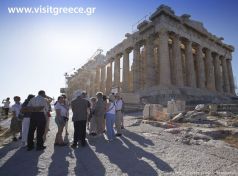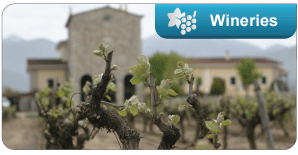Wine tourism in Central Greece
Central Greece is the southern section of the mainland. It is a large area of varying relief and landscapes that includes mountain masses, lowlands and an extensive coastline. Wine tourism in Central Greece is concentrated in the eastern section, in the areas of Fthiotida, Viotia, Evia and Attica, where the vineyards are located. Quite a few are to be found in areas of tourist interest, but most are located along the roads leading to these areas.
Beginning wine tourism in Central Greece from its centre, it is dominated by the imposing Mt. Parnassos, the most popular mountain destination in Greece, particularly in winter when the Parnassos Ski Centre is in operation. The PGI Parnassos varieties of wine are produced on the northern and eastern slopes of the mountain. Located in the southwestern foothills, the archaeological site of Delphi is known worldwide, and another notable destination is the Vagonetto mining museum.
In the northeastern section of the mainland, the modern vineyard of Fthiotida is being developed on the slopes of the Othrys, Oiti, Kallidromo and Knimida mountains and produces the PGI Slopes of Knimida and PGI Atalanti Valley wines. In Fthiotida, wine tourism in Central Greece is ideally combined with archaeological tourism through the scattered archaeological sites and monuments that reveal its history. Thermopylae, ancient Elateia, the ancient cities of Ales, Echinos and Kynos, the castles of Lamia and Mendenitsa, the Lamia Archaeological Museum, the Atalanti Archaeological Museum and the Fthiotida Byzantine Museum in Ypati are just a few of the places visitors can see.
Wine tourism in Central Greece continues to the south with the extensive vineyard of Viotia, which has its own scattering of ancient sites in the southeastern section of Viotia (ancient Thebes, Kavirio, Akrefnia, the acropolis of Glas, Cheronia, Aliartos, Orchomenos, Thisvi, Thespies, Eutrisi, Davlia). It was in this area that Hesiod refers to Vivlinos wine. Visitors here can also see the medieval castle in Livadia, the monastery of Hosios Loukas, the Thebes Archaeological Museum, the Schimatari Archaeological Museum and the Cheronia Archaeological Museum. A very popular destination is the mountain town of Arachova with developed tourism facilities.
Wine tourism in Central Greece includes the island of Evia, the second largest in Greece. It is at the eastern tip of the mainland and includes the mainland section of Ritsona, in the historic area of Avlida, where the PGI Ritsona Avlidos wines are produced. The PGI Lilandio Pedio wines are produced south of Chalkida, in the area through which the River Lilas flows. The prehistoric settlement of Manika, the fortress of Karababa and the archaeological museum in Chalkida, ancient Lefkanti to the south and ancient Eretria even further south are just some of the sites at which visitors to Central Evia can stop. There are also vineyards in Southern Evia, where the PGI Karystos wines are produced. Southern Evia also features a scattering of ancient sites in Aliveri, Dystos, Kimi and in Karystos. Of great interest are the Drakospita (dragon houses) in Southern Evia, the Karystos Archaeological Museum and the Kimi Folklore Museum. There is significant vine cultivation in Northern Evia, where the archaeological site of Artemissio is worth visiting.
Wine tourism in Central Greece comes to an end at its southeastern tip, with the vineyards of Attica, one of the largest in Greece and which are developing around, and occasionally very close, to the capital of Athens. Among the many sites in Athens and Piraeus, visitors should not miss the Acropolis and the New Acropolis Museum (one of the best museums in the world), the ancient Agora and the Stoa of Attalos Museum, Keramikos and its museum, the National Archaeological Museum, the Byzantine and Christian Museum, the Benaki Museum, the National Gallery, Panathenaic Stadium (Kallimarmaro) and the Piraeus Archaeological Museum. In Eastern Attica, where most of the vineyards are located and many PGI wines are produced, the main sights are the Temple of Poseidon in Sounio, the Lavrio Archaeological Museum, the ancient site of Vravronas and its museum, the Marathon Archaeological Museum, the Amphiareion of Oropos and the Zygomalas museum in Avlonas. In Western Attica, where many PGI Gerania wines are produced, the most important sights are the archaeological site of Elefsina and its museum, the archaeological sites of Eleftheron and Aegosthena and the Megara Archaeological Museum.




